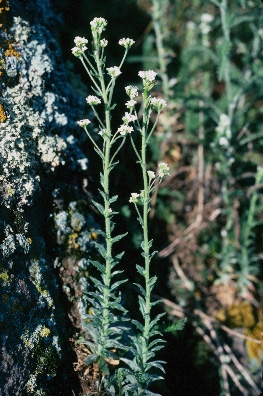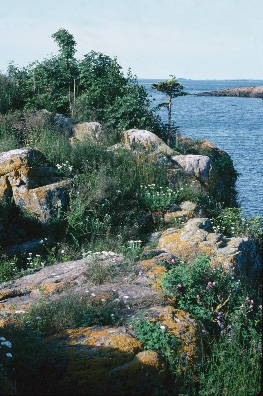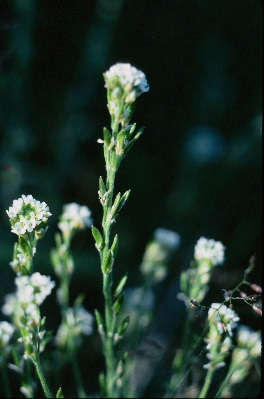Plants and Animals
Draba incana Twisted whitlow grass
Key Characteristics
Small forb (10-40 cm) of rocky shores; basal rosette of small leaves; stem leaves numerous (< 20); flowers white with four petals, flower stalk densely hairy; fruits elongated, flattened.
Status and Rank
US Status: No Status/Not Listed
State Status: E - Endangered (legally protected)
Global Rank: G5 - Secure
State Rank: S1 - Critically imperiled
Occurrences
| County | Number of Occurrences | Year Last Observed |
|---|---|---|
| Keweenaw | 2 | 1995 |
Information is summarized from MNFI's database of rare species and community occurrences. Data may not reflect true distribution since much of the state has not been thoroughly surveyed.
Habitat
Known from rock crevices on small outcrop islands in Lake Superior; inhabits steep northwest facing rock faces with sparse vegetation.
Natural Community Types
For each species, lists of natural communities were derived from review of the nearly 6,500 element occurrences in the MNFI database, in addition to herbarium label data for some taxa. In most cases, at least one specimen record exists for each listed natural community. For certain taxa, especially poorly collected or extirpated species of prairie and savanna habitats, natural community lists were derived from inferences from collection sites and habitat preferences in immediately adjacent states (particularly Indiana and Illinois). Natural communities are not listed for those species documented only from altered or ruderal habitats in Michigan, especially for taxa that occur in a variety of habitats outside of the state.
Natural communities are not listed in order of frequency of occurrence, but are rather derived from the full set of natural communities, organized by Ecological Group. In many cases, the general habitat descriptions should provide greater clarity and direction to the surveyor. In future versions of the Rare Species Explorer, we hope to incorporate natural community fidelity ranks for each taxon.
Associated Plants
Ticklegrass, yarrow, bearberry, marsh bellflower, pale Indian paintbrush, hair grass, spike-rush, butterwort, ninebark, silverweed, dwarf Canadian primrose, wild rose, rough cinquefoil, harebell, and bluejoint grass.
Management Recommendations
Little known of the biology and ecology of this species, although it likely benefits from disturbance that creates and maintains openings and colonization sites. It primarily requires protection of the shoreline habitat and perpetuation of natural disturbance (winter ice, storms, wind) and hydrological regimes. This community occupies a stressed, potentially unstable environment; many of the species found in this community do not tolerate later stages of succession and require management that prevents woody plant encroachment. Protect from development.
Survey Methods
Random meander search covers areas that appear likely to have rare taxa, based on habitat and the judgment of the investigator.
-
Meander search
-
Survey Period: From first week of August to fourth week of August
-
References
Survey References
- Elzinga, C.L., D.W. Salzer, and J.W. Willoughby. 1998. Measuring and Monitoring Plant Populations. The Nature Conservancy and Bureau of Land Management, Denver. BLM Technical Reference 1730-1. 477pp.
- Goff, G.F., G.A. Dawson, and J.J. Rochow. 1982. Site examination for Threatened and Endangered plant species. Environmental Management 6(4): 307-316
- Nelson, J.R. 1984. Rare Plant Field Survey Guidelines. In: J.P. Smith and R. York. Inventory of rare and endangered vascular plants of California. 3rd Ed. California Native Plant Society, Berkeley. 174pp.
- Nelson, J.R. 1986. Rare Plant Surveys: Techniques For Impact Assessment. Natural Areas Journal 5(3):18-30.
- Nelson, J.R. 1987. Rare Plant Surveys: Techniques for Impact Assessment. In: Conservation and management of rare and endangered plants. Ed. T.S. Elias. California Native Plant Society, Sacramento. 8pp.
Technical References
- Flora of North America Editorial Committee. 2010. Flora of North America, North of Mexico. Volume 7: Magnoliophyta: Salicaceae to Brassicaceae. Oxford Univ. Press. New York, NY. 797 pp.
- Gleason, H. A., and A. Cronquist. 1991. Manual of Vascular Plants of Northeastern United States and Adjacent Canada. 2nd Ed. The New York Botanical Garden, New York, New York.
- Gray, A. 1950. Gray's Manual of Botany; eighth ed. Van Nostrand Reinghold, New York. 1632pp.
- Holmgren, N.H. 1998. Illustrated Companion to Gleason and Cronquist's Manual. Illustrations of the vascular plants of Northeastern United States and adjacent Canada. New York Botanical Garden, Bronx. 937pp.
- Scoggan, H.J. 1978. The Flora of Canada. National Museum of Natural Science Publications Botany 4: 1711pp.
- Voss, E. G. 1985. Michigan Flora. Part II. Dicots (Saururaceae-Cornaceae). Bulletin of the Cranbrook Institute of Science and University of Michigan Herbarium. 724pp.




